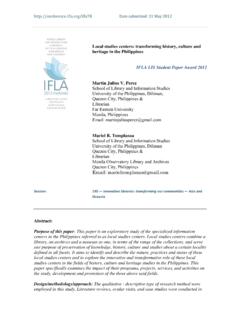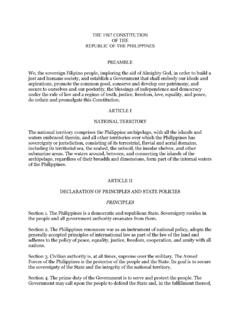Transcription of Features and Historical Aspects of the Philippines ...
1 European Journal of Contemporary Education, 2012, Vol.(2), 2. UDC 378. Features and Historical Aspects of the Philippines Educational system 1 Sajid Musa 2 Rushan Ziatdinov 1-2 Department of Computer & Instructional Technologies, Fatih University, 34500 B y k ekmece, Istanbul, Turkey 1 Research Student E-mail: 2 PhD (Mathematical Modeling), Assistant Professor E-mail: URL: Abstract. This article deals with the Features of the philippine educational system. Additionally, brief and concise information will be given on how the educational system came into existence, the organization and the structure of the system itself. This paper also tackles the obstacles and problems observed in the past and up to the present, and gives possible solutions to these. We also made sure to give some useful recommendations and suggestions on how the education system can be improved, which were enlightened by the steps taken by some wealthy neighboring countries in the region.
2 Based on the study, further understanding of the shortcomings of the country, not only in education but also in the essential aspect of nationalism , were found. The originality of this work can be seen in the brief explanation of the philippine educational system, as well as its Historical Aspects , and the detailed comparison of different eras of the educational system. Keywords: education system; organization and structure; Philippines ; history of education. 1. Introduction The educational system of the Philippines has a long and complicated history. Probably the first comprehensive research conducted dealing with the supposed medium language of teaching was accomplished by Andrew Gonzalez (1992, 1998), who also discussed the educational system of the Philippines and its Historical Aspects , together with the interlocking conflicts and resulting problems of higher education in the Philippines . Catherine Young (2002) discussed the Pilipino language as the medium of instruction in the country's educational system, as well as proposed an alternative, ideological model of literacy which develops the critical thinking skills of filipino students, builds cognitive and affective domains, and values their local language experience and culture.
3 The absence of detailed comparisons (see Table 1) of different stages of development of the educational system, and a brief and concise explanation of the challenges in the educational system, was a great opportunity for us to undertake this research. Curriculum policies, such as the 1987 Constitution of the Republic of the Philippines Article XIV, are usually set forth by the Department of Education, Culture and Sports of the Philippines with different bulletins, circulars, memoranda, orders and plans. These bodies of government are sorted by national priority and contribute to the success of development goals (Mari as & Ditapat 1995). However, few of the laws passed by the national legislation regarding the school curriculum: Section 3(10), Article XIV of the Constitution mandate the study of the Philippines Constitution; Section 6, Article XIV, implement filipino as the main language of instruction; Section 19(2), Article XIV, declares that: All the educational institutions throughout the country shall undertake regular sports activities in cooperation with athletic clubs and other sectors.
4 Republic Act No. 4723 ordered the teaching of music in schools. The newly curriculum-specific laws designate: a) Lengthening of the school calendar from 185 to not less than 200 school days per school year;. 155. European Journal of Contemporary Education, 2012, Vol.(2), 2. b) Integration of concepts on human rights, the environment, dangerous drugs and computer education. Table 1. Comparison of the present study with the previous work in the same field. Concise view of the Authors/Year Paper title study Conclusion (Problems/Findings). Present Features and The educational If stabilized and well- Historical Aspects of system of the carried out curricula the philippine Philippines has been are present in the educational system. greatly influenced by whole country with events in the past the full backing of the thus resulting in the government, this different challenges might lessen the and problems in the insufficiencies in the present.
5 Educational system. Catherine Young First language first: The language Whether or not the (2002) literacy education for challenge of the language and culture the future in a country based on will continue as multilingual most filipino socio- components of a philippine society linguistics is the dynamic, viable problem of society is a complex reconciling the process of which competing education is a necessitates of potentially ethnicity, nationalism significant factor. and modernization. Embedded in so many unfamiliar things such the textbooks depicting other cultures and most crucially, even the language used in teaching is foreign. Andrew Gonzalez The language The presence of The language (1998) planning situation in languages in various condition in the the Philippines domains, especially Philippines has been in the area of both a positive and education, is negative factor in described and today's providing the policy on the education and the country's version of communication bilingual education is needs of Filipinos.
6 Emphasized and evaluated. This is followed by a Historical sketch of language planning from laws enacted, revised and mandated. 156. European Journal of Contemporary Education, 2012, Vol.(2), 2. Andrew Gonzalez Higher education, The continued The analysis of the (1992) brain drain and mismatch of the philippine case will overseas graduate students to provide some employment in The their intended insights into more Philippines : towards workplaces is general a differentiated set of aggressively characteristics solutions increasing every year. applicable to other Unfortunately, some developing countries scientists along with added with the others who have supply of manpower attained a high within the country, degree of education especially in the on their respective areas of high-level fields migrate to scientists, academics other countries, thus and well-trained making the shortages technicians between even more acute.
7 Engineers and skilled craftsman. Main results In this paper, we look at the past in order to ascertain the background on how the educational system came to be in its present form. It started from the early filipino settlers, followed by the various changes in the different eras, covered by the Spaniards, the Americans and the Japanese. After exploring the history and dealing with respective changes, this will allow us to pinpoint the problems of the present. Our work has the following Features : The previous works in this field have been compared with the present one in a very thorough way;. The summarized view of the advantages and disadvantages of the educational system have been researched from the early filipino settlers, during the reign of the colonizers through to today's current conditions;. The rankings of the country's leading universities among all the universities around the globe and Asia are shown in the context of different individual areas.
8 There are also however several deficiencies: This work describes the educational system in general, but does not deal with problems in specific areas like science and engineering education, which are highly-developed in neighboring countries;. The impact of information technologies on educational systems is not discussed at all, despite the fact that it is very important in education these days;. Since progress is observed in the country's neighboring countries, we lack further explanation on that, and how to be like them', without becoming non-nationalistic. Organization The rest of this paper is organized as follows. In Section 2, we briefly discuss the management system and structure of the Department of Education in the country. Section 3. narrates the history of the formation and development of the educational system. Then in Section 4, the organization and structure of the education is emphasized.
9 While in the Sections 5 and 6 we tackle the problems then give the possible solutions and recommendations. Finally, we conclude our study and future work in Section 7. 157. European Journal of Contemporary Education, 2012, Vol.(2), 2. 2. Department of Education (DepEd) Management Structure From 2001, the Department of Education, Culture and Sports became the present Department of Education (DepEd) * (see Table 2). The Department is categorized into two major components to fulfill its mandates and objectives. The overall administration of basic education at the national level is maintained by the Central Office. The Field Offices are in charge of the regional and local coordination, and administration of the Department's authoritative order. Republic Act 9115 grants that the Department should only have at most four Undersecretaries and four Assistant Secretaries with at least one Undersecretary and one Assistant Secretary who are career service officers selected from the staff of the Department.
10 Currently, the Department functions with four Undersecretaries in the areas of: Programs and Projects;. Regional Operations;. Finance and Administration;. Legal Affairs. Four Assistant Secretaries in the areas of: Programs and Projects;. Planning and Development;. Budget and Financial Affairs;. Legal Affairs. Various bureaus, services and centers give aid to the Office of the Secretary at the Central Office. Three staff bureaus namely: the Bureau of Elementary Education (BEE), the Bureau of Secondary Education (BSE), and the Bureau of Non-Formal Education (BNFE) are tasked with providing assistance in formulating policies, standards, programs with regard to curricula and staff development. Last 25th of August, 1999 With the Executive Order from the series of 1999, the functions of the remaining bureau, the Bureau of Physical Education and School Sports (BPESS), are shouldered by the philippine Sports Commission (PSC).















